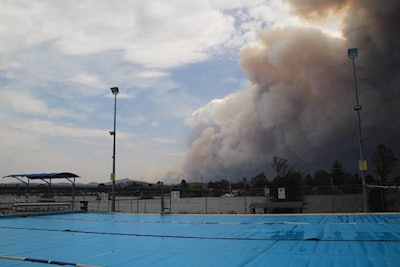
The wildfires and resulting ash in the Western states have been devastating, and the resulting ash can be carried for long distances and might be getting into many pools and spas.
Service techs and retail stores want to know how to deal with the ash. What does ash in pool/spa water do chemically? Can it be dangerous? What should service techs do? How badly can it mess up water balance? What should retailers tell their customers? Or, is it a problem at all? How concerned should we be?
Learning a little about fire and wildfires will help to understand what we are dealing with and that will lead us to a plan for handling it.
RELATED: Pool Care and Repair After Wildfires
When something burns, it transforms that fuel into materials with different physical and chemical properties. One of the materials is ash, which is the particulate residue remaining on the ground or carried in the thermal wind currents around the wildfire.
The quantity and characteristics of the ash produced depend on:
1. The quantity of what was burned
2. The type of material burned (forest, homes, other structures)
3. The combustion completeness (burning temperature)
What’s in the Ash Depends on the Temperature of the Fire
At low combustion completeness temperatures < 840 degrees Fahrenheit, ash is high in organic carbon. This is called pyrogenic carbon. Not important, I just thought it sounds cool.
At high combustion completeness temperature > 840 degrees Fahrenheit, most of the organic carbon is volatilized and the remaining mineral ash has an elevated pH when in water. It is composed mainly of calcium, magnesium, sodium, potassium, silicon, and phosphorous in the form of inorganic carbonates.
RELATED: Dousing The Flames
At very high combustion completeness temperature > 1076 degrees Fahrenheit most forms are oxides. This has a high pH of 11.0 or higher.
Ash produced at lower combustion completeness temperature is usually darker, coarser, and less dense. High-temperature ash is mostly white and less dense.
Chemical Characterization
The big constituents of ash from burning forests are, in order, sulfate, ammonia, phosphate, nitrate, naphthalene, biphenyl, iron, copper, calcium, magnesium, sodium, chloride, silica, with a pH of about 11.0. The constituents change when houses and other structures burn and when fire-fighting efforts spray or drop flame-retardant chemicals. But I could not find a complete analysis of ash from a combination of homes, structures, and forests.
The fire retardant is mono- or di-ammonium phosphate. So, it depends on how much gets in the pool. And don't forget that ash doesn't weigh much. After all, the ash got there in the wind. A 15,000-gallon pool is 125,000 lbs of water. One ppm is about 2 oz. Ash is alkaline so the pH may be high. Phosphates may go up depending on fuel and temperature. Ammonia and chloramines may go up too.
Not all of the ash is soluble. Much of it will remain insoluble. However, it is ash and it is fragile. It can “break” into smaller particles. Think of a piece of paper burning. The resulting ash is usually a few large pieces but if you try to pick it up or even blow on it and it breaks into many smaller particles. Same thing in the pool water. When that ash hits the pump impeller that is spinning at 1,000 to 3,400 RPM guess what happens? Yep, hundreds or thousands of smaller particles. The pieces may be smaller than the filter can remove. So they can go right through the filter and return to the pool.
RELATED: Tips For Firepit Safety
Course of Action
The first thing to do is to rinse off surrounding structures, landscaping, and decks. The reason is that a high wind or some rain will wash all of the ash from everything and it may get into the pool water.
- Now, turn off the pump
- Skim or bag slowly so you don’t break up the ash
- Clean the skimmer basket and pump strainer basket
- Turn on the pump
- Check the pressure gauge, backwash or clean the filter if needed
- Check the water level and refill to the middle of the skimmer opening
- Vacuum to waste (slowly as ash can break apart or re-distribute in water above the vac)
- Adjust water balance: pH 7.4-7.6 and TA 80-100 ppm
- Check sanitizer (usually chlorine) and raise to 10 ppm to shock
- Run the pump 24/7 for 3-4 days and check the pressure gauge frequently
- Check phosphates and if high (>500 ppm), use a phosphate remover
If water is cloudy after the above procedure, use a polymer or chitin clarifier or floc with alum. Enzymes can be helpful to remove oils and hydrocarbons. A sock or shield in the skimmer can help if ash has broken apart.
Additionally, if there is a huge amount of ash in the pool or if the ash is mostly from man-made materials, it may be better to drain and refill.











































